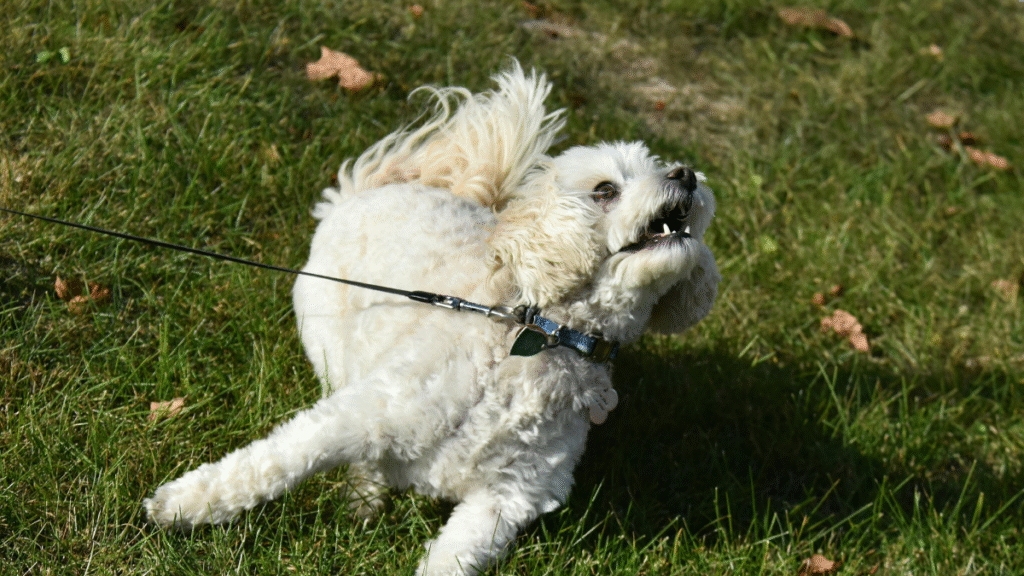Teaching your dog tricks is one of the best ways to engage with your pet, improve obedience and focus, and keep them active and entertained. Tricks like spinning are not only fun but also very impressive — who wouldn’t want a dog that can spin on command?
Whether you’re a new pet owner or an experienced trainer, here’s everything you need to know about teaching your dog to spin.
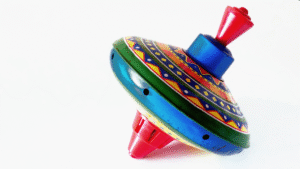
Why Should You Teach a Dog to Spin?
Before we dive into the step-by-step training process, it’s worth taking a moment to understand why teaching your dog to spin is beneficial.
After all, there are countless dog tricks out there. While some, such as Shake or Sit, are common staples, you might wonder what makes spinning worth adding to your dog’s trick list.
Here are some great reasons to teach your dog this entertaining trick:
-
Mental Stimulation: Learning new commands provides an excellent mental workout, keeping your dog active, alert, and engaged.
-
Physical Exercise: The act of spinning helps improve coordination, balance, and flexibility.
-
Improved Focus: Training tricks strengthens your dog’s ability to pay attention and reinforces your role as their leader.
-
Confidence Building: Learning new behaviors helps boost your dog’s confidence and sense of security.
-
Bonding: Spending quality time training and playing strengthens the bond and trust between you and your dog.
Once your dog can spin reliably, you can also incorporate it into other routines or commands — such as agility training, dog dancing, or even therapy dog demonstrations.
Tools Required for Training a Dog to Spin
Training your dog to spin is one of the simplest tricks to teach, and it doesn’t require any special equipment. The only optional tool is a dog clicker if you prefer using marker-based training.
Here’s what you’ll need to get started:
-
Training Treats: Choose small, soft, and tasty treats that your dog loves. Bite-sized pieces are best so your dog doesn’t spend too long chewing.
-
Dog Clicker (optional): If you use positive reinforcement with a marker like a clicker, have one handy.
-
Quiet Space: Select a location free from distractions so your dog can focus on you.
-
Patience and Consistency: As with all training, staying patient and consistent is crucial for success.
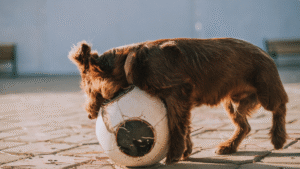
Step-by-Step Training Guide
There are several ways to teach your dog to spin, but luring combined with positive reinforcement is the most effective and widely recommended method.
Follow these six simple steps to have your dog spinning confidently in both directions.
Step 1: Get Your Dog’s Attention
Start with your dog standing and focused on you. Hold a treat close to their nose so they can smell it clearly.
The treat acts as a lure, guiding your dog to follow it in a circular motion. You’ll use it to show your dog the movement of the spin.
Step 2: Lure the Dog Into a Spin
Move your hand (holding the treat) in a slow, circular motion around your dog’s head. As they follow the treat with their nose, their body will naturally begin to turn.
Once your dog completes the full circle, immediately mark the behavior by saying “Yes!” or clicking your clicker, and then reward them with the treat.
Repeat several times until your dog starts to understand that following your hand around in a circle results in a treat. Focus on one direction first — either clockwise or counterclockwise.
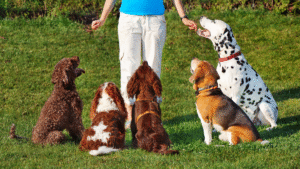
Step 3: Add a Cue Word
After your dog consistently follows the lure, introduce a verbal command. Popular cue words include “Spin,” “Turn,” or “Twirl.” Choose one and use it consistently.
Say your cue word in an upbeat tone (for example, “Spin!”) just before moving your hand in a circular motion. When your dog completes the spin, mark and reward immediately.
With repetition, your dog will begin to associate the word with the spinning motion.
Step 4: Reduce the Lure
Once your dog reliably spins in response to the verbal cue, begin fading out the lure. Gradually reduce the size of your hand movement until you can perform the cue with just a small hand signal or even no hand movement at all.
You can switch to using an open palm or a subtle wrist motion instead of holding a treat.
Step 5: Train the Opposite Direction
Once your dog has mastered spinning in one direction, teach the opposite side. Use a different cue word, such as “Twist” or “Reverse,” to help them distinguish between the two.
Repeat the same process as before, but this time move your hand in the opposite direction. With practice, your dog will learn to spin both ways on command.
Step 6: Reinforce and Practice
Consistency and repetition are key to mastering any trick. Practice a few short training sessions each day — ideally 5 to 10 minutes long. Always end on a positive note with praise and a reward.
Once your dog reliably performs the trick indoors, practice in new environments with increasing levels of distraction, such as your backyard or a park.
Common Mistakes When Training a Dog to Spin
Even though spinning is a simple trick, it’s easy to run into challenges if you make common mistakes. Here are some pitfalls to avoid:
-
Moving Too Quickly: Training is a gradual process. If your dog seems confused, go back a step and simplify the exercise.
-
Skipping Rewards: Positive reinforcement is the cornerstone of dog training. Always reward your dog for performing the correct behavior.
-
Overly Long Sessions: Keep training sessions short and engaging. Long sessions can lead to boredom or frustration.
-
Inconsistency: Use the same cue word and hand signal each time. Consistency speeds up learning.
-
Ignoring Comfort: Some dogs may get dizzy or anxious from repeated spins. Watch for signs of stress and reduce the number of repetitions if needed.

How Long Does It Take to Train a Dog to Spin?
The time it takes depends on your dog’s age, temperament, and training experience.
In general:
-
Puppies and young dogs are usually more playful and pick up new tricks faster.
-
Older dogs can still learn just as well but may need more time and patience.
On average, most dogs can learn to spin on command within one to two weeks of consistent, positive training.
Troubleshooting: What to Do if Your Dog Isn’t Learning
If your dog seems stuck or uninterested, try these tips:
-
Use higher-value treats: Offer something irresistible, such as small bits of chicken or cheese.
-
Reward smaller progress: If your dog stops halfway, reward partial turns and gradually build up to a full spin.
-
Pick the right time: Train when your dog is alert and focused — not tired or overly excited.
-
Stay positive: Never use force or frustration. Take breaks and keep training sessions upbeat and fun.
Remember, every dog learns at their own pace. The goal is progress, not perfection.
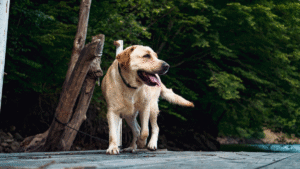
Adding More Fun: Tricks and Variations Involving Spinning
Once your dog has mastered the spin, you can add variations to make training more exciting. Try these fun ideas:
-
Spin in both directions: Alternate between “Spin” and “Twist” commands for variety.
-
Combine with other tricks: Link spinning to other commands like “Sit,” “High Five,” or “Roll Over.”
-
Dog dancing: Add music and turn the spin into part of a dance routine.
-
Exercise warm-up: Use spins as a light warm-up before walks or agility sessions.
-
Focus redirection: Use the spin command to refocus your dog during walks or training.
Wrapping Up
Teaching your dog to spin on command is a simple, fun, and rewarding experience for both of you. It’s an excellent way to keep your dog mentally and physically active while deepening your bond.
With patience, consistency, and positive reinforcement, your dog will soon be spinning with joy and pride. Stick with the process, celebrate progress, and enjoy every moment of learning together.
- 5 Cheap Alternatives To Dog Training Equipment - November 12, 2025
- Homemade Calming Spray To Help Dogs During Training - November 12, 2025
- 7 DIY Dog Training Tools You Can Make From Household Items - November 12, 2025
